No longer confined to the pizza and Chinese segments, restaurant delivery has gone from a bonus to a necessity in just a few years. Since 2012, delivery visits are up 10% and sales are up 20%, according to The NPD Group.
Although the off-premise channel accounts for just 3% of all restaurant orders at this time, that number is expected to rise quickly as digital ordering grows and as companies scale through third-party aggregates. Morgan Stanley predicts that delivery could account for 30% to 40% of industry sales within the next few years.
Such a prediction makes sense when considering that digital ordering and delivery have been growing 300% faster than dine-in traffic since 2014.
“Our original forecast through 2022 suggested growth of another 5%, but that was a few years ago. Seeing what I see now, I would expect it to grow even more,” NPD Group VP David Portalatin told Restaurant Dive.
The idea of delivery in QSR isn’t new. Burger King introduced BK Delivers all the way back in 2012, though the technology wasn’t quite up to speed — customers could either order online or call a toll-free number — and the demand was nowhere near it is now. Today, delivery is very much a part of growth plans for restaurant businesses big and small.
A quick glance at the top 8 quick-service brands’ delivery adoption from the past year alone illustrates this steep growth trajectory:
- McDonald’s expanded its partnership with Uber Eats.
- Starbucks announced that nearly a quarter of its U.S. stores will start offering Starbucks Delivers in early 2019 through Uber Eats
- Subway expanded delivery to 9,000 restaurants through partnerships with Uber Eats, Grubhub, DoorDash and Postmates
- Taco Bell is able to leverage parent company Yum Brands’ partnership with Grubhub announced in February 2018
- In the spring of 2018, Burger King announced it was testing delivery at several hundred restaurants throughout the country
- Wendy’s started offering delivery nationwide through DoorDash in late 2017
- Chick-fil-A announced delivery at more than 1,100 of its restaurants through a partnership with DoorDash
- And, Dunkin’ continues to expand third-party delivery options with the goal of creating a combined catering/delivery platform this year
It's clear the industry has passed a tipping point on delivery.
“We’re in a place now where there’s no going back. [Delivery] has reached the same level as e-commerce in that it’s here to stay,” Ben Gaddis, president of Austin-based innovation agency T3, told Restaurant Dive. “The second I realized I could get my favorite taco on Saturday mornings without having to get my two kids dressed and get them into the car and drive across town was when I realized I’m not going through that anymore. I’ll pay $5 extra every day to make that happen.”
New research from Zion & Zion shows that people with income under $10,000 order via online delivery the most compared to any other income bracket, so Gaddis’ experience seems to be a universal one: consumers are willing to pay more for convenience no matter what.
"We’re in a place now where there’s no going back. [Delivery] has reached the same level as e-commerce in that it’s here to stay."

Ben Gaddis
President, T3
Such convenience facilitated by digital ordering represents a new normal — consumers now expect the service. But that doesn’t mean restaurants have figured out how it best applies to their businesses quite yet. Right now, the restaurant industry’s approach to delivery — pizza notwithstanding — resembles a big bowl of spaghetti. Some brands have added an exclusive aggregate partner, while others have multiple. Some have integrated their aggregates’ technology into their point-of-sales, others use disparate iPads from each company at the front counter. Some have the right packaging in place, while others are trying to figure out how to avoid soggy fries. So on and so forth. These types of logistics, however, pale in comparison to the biggest question looming over delivery.
“The biggest question is whether or not [brands are] going to have a proprietary channel or leverage a third-party aggregator. I believe the larger chains with the bigger budgets and more sophisticated infrastructure are going to develop proprietary systems, while the smaller and independent brands will go with third-party systems,” Portalatin said. “The most important thing is that delivery is one of the few growth opportunities left in the restaurant landscape, so restaurant operators know they have to do something. The reason for that is we are increasingly consuming our meals at home. I don’t see that changing.”
Panera takes a risk
An industry case study in taking the proprietary approach is Panera. The company launched delivery in 2014 with its own fleet. Now it offers delivery in nearly 75% of its system across the country and expanded the service last year to include breakfast.
Panera ramped up delivery on its own — its in-house fleet now includes more than 10,000 new drivers and the service has created a total of 13,000 jobs since it launched. According to Inc., the cost of taking a proprietary approach is about $15,000 for each of Panera’s 2,000 stores — or a cool $30 million.
But the company has plenty of incentives to invest heavily in this service. For starters, it can. As the 11th biggest chain by sales in the U.S., Panera pulled in about $5.5 million in 2017.
In May, Panera CEO Blaine Hurst credited delivery for fueling Panera’s next phase of growth.
“The success we have seen so far is exciting. The combination of providing clean food options via an entirely digital experience is giving us a real advantage, and the momentum is just beginning,” he said in a company release.
But such a hefty investment outlines one of the major challenges in implementing a proprietary delivery system. Costs come from every direction — labor, delivery vehicles, insurance, packaging and technology among them. Some argue, however, that it’s worth it.
“While it may be more costly to create your own delivery fleet, you get the benefit of having direct ownership of the customer relationship and you can manage the quality of that experience,” Gaddis said. “Panera gets to control all of that.”
Portalatin adds that there are two big advantages to taking a proprietary delivery approach — it gives the restaurant total control over the customer experience from the time the meal is ordered until the time the meal is delivered and it gives the restaurant complete control over customer data.
“When you have Uber Eats running analytics on your delivery data and then approaching independent restaurants with untapped opportunities in the same market, you have to ask if your third-party partner is really a partner or partially a competitor,” he said.
“While it may be more costly to create your own delivery fleet, you get the benefit of having direct ownership of the customer relationship and you can manage the quality of that experience."

Ben Gaddis
President, T3
In addition to controlling the data and the customer experience, the service costs that come with aggregate partnerships are also a major concern. Third-party delivery companies charge anywhere from 15 to 30% for delivery services. In a thin-margined industry with growing headwinds such as labor costs, this can be a burden too great to bear for some operators. Those restaurants are also unlikely to pass any costs onto the menu, since consumers are also often on the hook for a small delivery fee.
This is why some smaller eateries, like Houston-based Fajita Pete's, have made the decision that the investment for an in-house delivery system is, indeed, worth it.
“For us, it was a no-brainer. We take so much care in making sure our customers have a good experience, it’s important we have control of that relationship,” Founder Pete Mora told Restaurant Dive. “Our delivery business is big and often it’s the only chance we have to make an impression on customers. When you use third parties, there’s a disconnect there.”
Because of that potential disconnect — as well as the fees — Mora believes more restaurants will wean off of delivery companies and develop their own fleets.
“It is weird to me that someone would give away 20% of their ticket in such a low-margin business,” Mora said. “There’s not enough meat on the bone. These restaurants are spinning their wheels and creating so much work for diminishing returns.”
Mora isn’t alone. Bareburger executives have hinted at their plan to leave third-party companies as well, citing not only the fees but the risk of those companies becoming competitors. The rise of ghost kitchens like Uber Eats' growing "virtual restaurant" footprint seems to support that prediction.
Third-party aggregates provide quick scale
Still, judging by the moves of most companies big and small in the quick-service space, third-party aggregates aren’t going anywhere anytime soon. Gaddis even predicts that third-party delivery will become more economical and even perhaps free for most providers.
“Any industry that has huge margins will get disrupted. Grubhub, Uber — they can command that type of price and fee now, but as it gets to scale, we’re not going to see it at 30% anymore. It’ll come down,” he said. “At some point, people will get tired of paying $17 for a $5 sandwich and it will have to come down. There will be innovation and incremental competition to help it come along.”
Fees and data ownership issues aside, third-party services can provide a way to quickly scale into the space for operators that don’t have the deep pockets of Panera — and there are a lot of them. According to Portalatin, there are 661,000 restaurants in the U.S. and about 320,000 of them are independent or one or two-store operators. Aggregates can help smaller operators level the playing field against digitally-savvy giants — open your Grubhub app and the local Cajun concept is listed alongside Qdoba, for example.
“There’s room for everybody in this space and it’s going to depend on the operator and what they are economically able to do and what they have the sophistication for,” Portalatin said.
Third-party aggregates are enhancing their services to provide more sophistication for small-to-mid-sized concepts that don’t have the technology infrastructure to seamlessly implement delivery via digital ordering. For example, Grubhub acquired payments and loyalty company LevelUp in 2018.
This space will continue to swiftly evolve, causing restaurants to rethink their approach to real estate, loyalty, messaging, operations — nearly everything, according to Portalatin.
“One of the biggest implications is that the barrier to new creative development just went from millions of dollars to virtually nothing,” he said. “I can now go start my concept with a third-party commissary — rent out the space and put up the virtual banner and try new things. I expect an explosion of this type of development to come from the explosion of delivery.”
Gaddis’ predictions for the near-future — as it continues to be disrupted by the advent and growth of delivery — is a bit more ominous.
“I think the restaurant space will start to look a lot like the wealth distribution in this country — a lot of companies at the top that have enough money to keep up with consumer trends, companies that purposefully exist to offer an experience, and companies in the middle,” Gaddis said. “A lot of those companies in the middle will be sucked up by delivery. The middle will become a dangerous place to be. Where Panera and other brands that are out ahead have an advantage [in that] they at least have more answers now than questions. The brands that aren’t yet asking questions are going to be in a tough spot.”
















